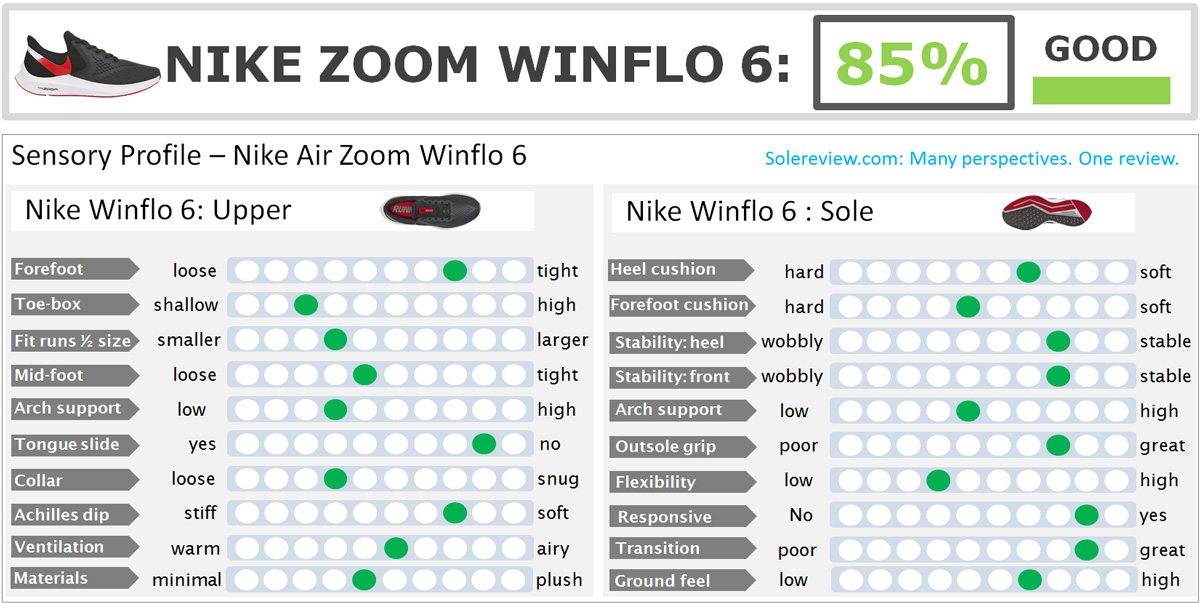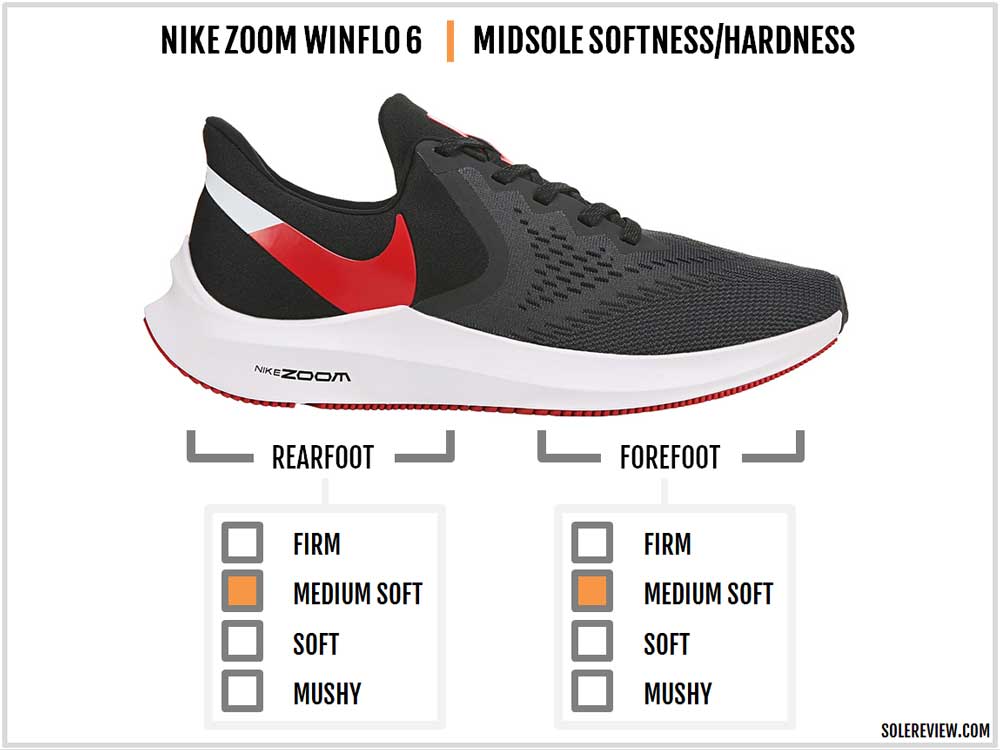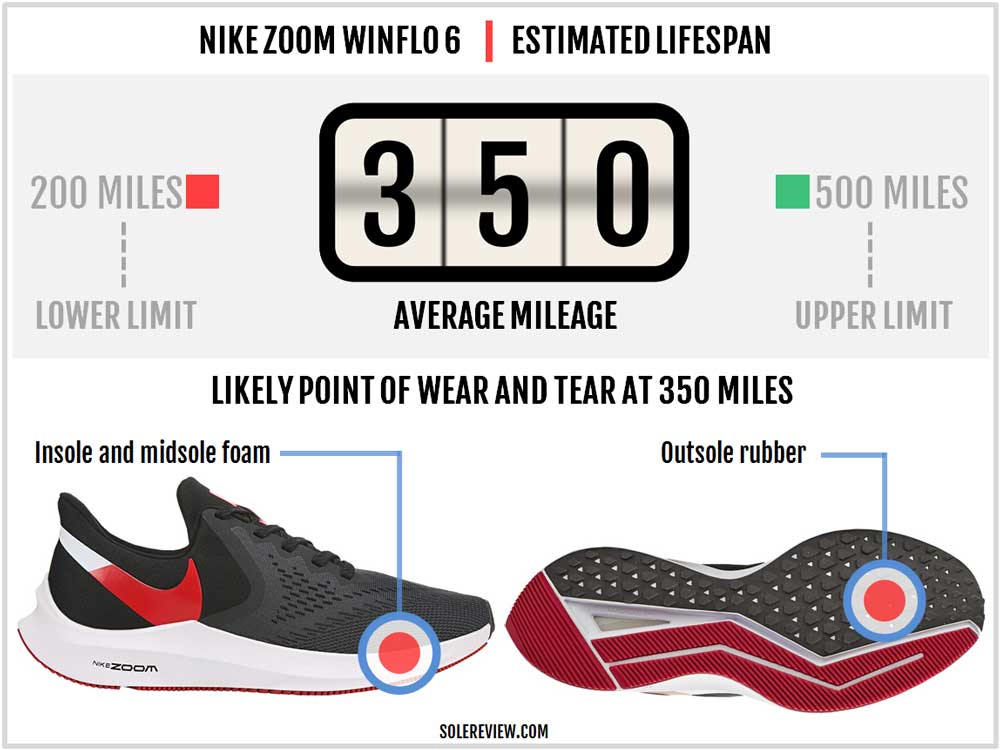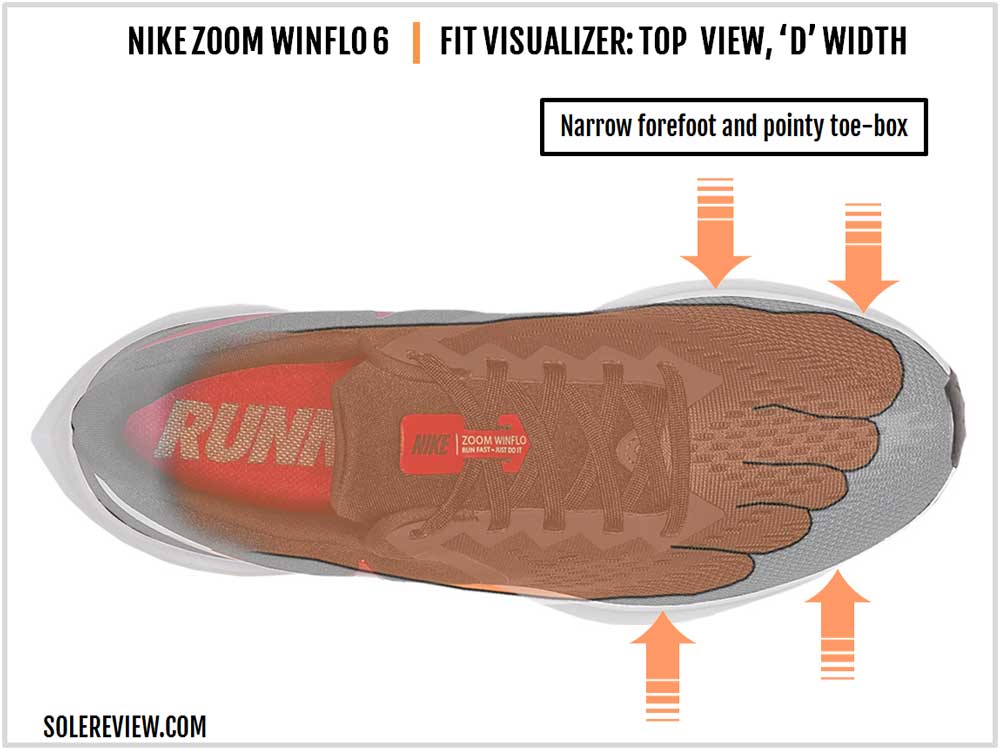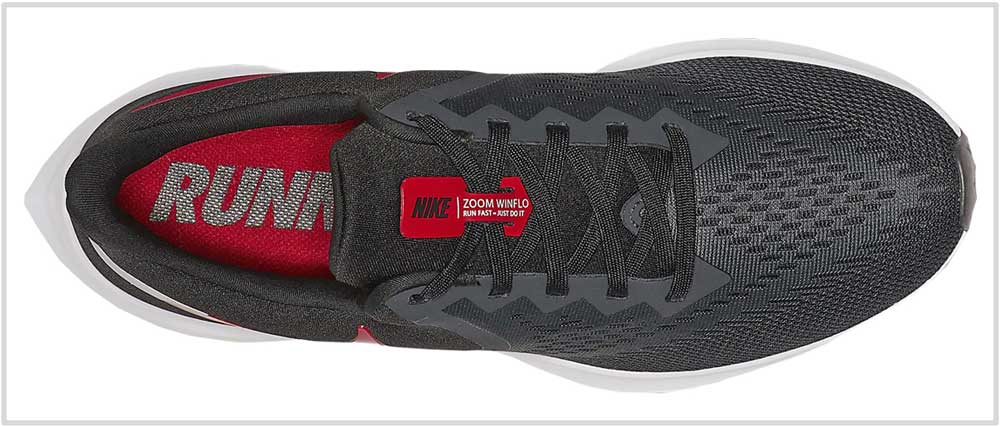INTRODUCTION
The Nike Winflo has earned its reputation not because of high-decibel marketing, but through the good old way – word of mouth feedback.
Over the last five years, the Winflo has found a following in runners who wanted a neutral Nike running shoe but without the Pegasus or Vomero price tag.
The franchise hasn’t disappointed – so far.
The Winflo 5 was a lightweight cushioned trainer with a responsive heel cushioning. The lighter build made it feel more agile than the Pegasus, and the Flywire-equipped upper did an excellent job at keeping the foot locked down in place. The Winflo 4 and 3 were equally competent.
And what of the Zoom Winflo 6?
The 2019 Winflo is a redesign from the ground up. Its new midsole adds another Zoom Air bag inside the forefoot. There was already one in the rear, so the Winflo 6 now has two Zoom Air bags – just like the Pegasus 33 and 34.
There’s a marked change in how the Winflo behaves on the road. And that’s not all; the new upper has a noticeably pointier toe-box and a heel design that is based on the Vaporfly Nike design language. So a sloped-out Achilles dip and high heel bevel are a part of the Winflo’s scenery.
The upper is also missing a set of lacing eyelets, so all these updates affect the upper fit.
Even with a narrower fit and firmer forefoot, the Winflo 6 continues to deliver excellent price-value. While it’s easy to see that the Winflo is built to a price, this is a versatile neutral trainer that can be had for $90 or less, depending on how good a deal you get.
Not only does its cushioned ride have a very neutral character, but its dual Zoom Air bags also make the midsole fun to run in. If you prefer your Winflo to be weather-resistant, there’s a seasonal Shield variant available with a water-beading reflective upper and a tackier outsole.
THE NIKE WINFLO 6 vs. WINFLO 5
The Winflo 6 has been reworked from the ground up, resulting in a significant difference between the two models. You’ll find the forefoot to be firmer and stiffer due to the newly-introduced Zoom Air bag. The rearfoot cushioning is softer and slightly more responsive because of how the Zoom Air bag is exposed under the heel.
The upper fit will divide people’s opinions – the toe-box is a lot pointier than the Winflo 5. This might not go down well with runners who appreciated the broad toe-box of the 5.
Also, there is one less eyelet than the V5 and a new Achilles ‘lip’. That makes the heel fit less secure. The reflective strip over the heel has been removed too. On the bright side, the tongue and heel feel plusher due to the new lining.
In light of all the changes, it makes sense to stick to the Winflo 5 unless you want a more responsive forefoot fit.
THE RIDE EXPERIENCE
The Winflo 6 is built on a clean-sheet design rather than sharing parts with the previous model. This update includes pairing another forefoot Zoom Air bag along with the existing heel Zoom Air.
A similar thing occurred when the Pegasus 32 switched over to the 33, so there’s a sense of deja vu with the Winflo update. Runners switching over from the V5 to the V6 will notice the firmer forefoot – regardless of whether you’re a forefoot striker or merely transitioning through the area.
Naturally, the sprung Zoom Air bag makes forefoot landings more responsive. At the same time, the Winflo 6 lacks the softness and flexibility of the 5 because of the difference in density between the foam and tightly sprung Zoom Air bag. The Zoom Air cushioning doesn’t work for everyone, so the Winflo 6 won’t cut it you like the smoother and pliable feel of a foam midsole.
As with all running shoes, ride preference is a personal choice.
Conversely, if you like the snappy feel of Nike Zoom Air, there’s a lot to like about the V6. Both the heel and forefoot feel responsive and efficient. A firmer forefoot results in quicker transitions and increases stability.
Nike’s Zoom Air has always been ‘it’s there but you can’t see it’ kind of cushioning technology. Sure, there were exceptions such as the ‘caged Zoom’ models. But by far, most Zoom Air units have come sealed inside a foam midsole.
The Winflo 6 changes that. There’s a window under the heel that exposes the drop-stitched Zoom Air bag.
Though this may seem merely decorative, the cavity helps the heel compress better. The crash pad is separated from the rest of the outsole by a groove so it splays when loaded and adds to the cushioning experience.
The rearfoot cavity branches forward into a transition groove that splits the outsole into two halves. The outer side has a ribbed texture while the inner outsole has regular raised lugs.
The traction is great. The continuous coverage of the outsole has plenty of grip while ensuring a seamless connection through the midfoot. The Vaporfly-inspired ‘boat’ heel midsole helps gradual rearfoot landings.
On the road, the Winflo 6 excels in many areas. The balance of cushioning softness and tight-sprung responsiveness makes the shoe suitable for various kinds of runs.
If one chooses to run long and slow, the Winflo packs ample cushioning under the foot. The Zoom Air units prevent the foam from flattening, and the said foam complements the midsole with softness. The molded EVA foam insole adds a comfortable layer of soft-top cushioning over the textile lining.
The midsole design produces a very neutral ride. The ‘ridges’ molded into the sidewalls on either side eliminates any kind of bias, hence making the heel supportive.
The firmness of the Zoom Air bag works in faster trainers such as the Rival Fly and the erstwhile Zoom Elite, and so it does for the Winflo.
Plonking a forefoot Zoom Air bag gives the Winflo a speedier ride character – more so that the Winflo 5. The latter weighs below 10-ounces so that helps as well. Also, feel free to use the Winflo on treadmills.
In short, the Winflo 6 is a versatile neutral trainer with a wide performance range.
Like any other running shoe, the Winflo 6 isn’t for everyone. The midsole has a fairly narrow waist, so one does not get the midfoot support of traditional neutral trainers.
The sidewall also takes a pointy shape under the midfoot so runners with wide feet might find them distracting. This isn’t the gradual flare of the Pegasus which hugs the arch; we suspect that Nike put it there just to make the shoe cool than to provide functional value.
And we still have the upper fit to talk about.
A three shoe rotation isn’t required here; the Winflo 6 is versatile enough to serve both as a daily trainer and long-distance shoe. Besides, buying a more expensive cushioned trainer defeats the purpose of the $90 Winflo.
Nonetheless – for a higher level of cushioning for marathons and such, we recommend either the Nike Epic React V2 or the New Balance 1080 V9. Both shoes have plenty of foam underneath to make multi-hour runs comfortable.
Road racers such as the Nike Zoom Streak 7, the New Balance 1400V6, or the Saucony Type A9 will make quick races and track runs better.
IS THE NIKE WINFLO 6 DURABLE?
Apart from the stray reports of adhesion failure of the heel outsole, the Winflo doesn’t have structural weak spots. Some midsole creasing will happen and the insole foam will compact over time – along with gradual wear and tear of the outsole.
The thin laces look flimsy but we haven’t come across fraying-related complaints so far.
THE UPPER DESIGN AND FIT
The Winflo’s toe-box is pointy. A lot pointier than the Winflo 5’s broad toe-box. With that also comes a narrower forefoot fit. Although Nike sells an extra-wide in this model, it’s not available globally. That means that most runners would have to live with the cramped toe-box – should they choose to get a pair.
A partial sleeve makes the insides of the midfoot smooth. It’s worth noting that the V6 loses the Flywire cords of the 5 – we don’t necessarily see this change as a downgrade but that’s something to keep in mind. The new heel and tongue lining have a softer hand feel.
The Winflo 6 now has only five lacing rows – which is one less than the last model. The heel-lock lacing eyelet is missing here. When you combine that with the outwards sloping collar design, the overall heel grip doesn’t feel as secure as the 5.
The heel doesn’t slip during runs. Yet, there’s a sense of looseness which wasn’t a part of the Winflo 5.
Otherwise, the fit is very secure in the front – a by-product of a narrow forefoot. Ventilation is average, neither too warm nor too airy.
This being a $90 MSRP shoe, there are signs of cost-cutting. The reflective strip over the heel isn’t there any longer. The flat laces feel a bit flimsy. The lack of reflectivity can be remedied by buying the Shield Version of the Winflo.
PROS AND CONS
Several factors make the Winflo 6 a good buy. The midsole foam and the Zoom Air units make the ride cushioned and responsive; the just-right softness makes the shoe versatile enough for different kinds of runs. The loading feels efficient and the outsole has excellent traction.
While most runners will appreciate the plush heel and tongue, the forefoot and heel fit may not find a lot of takers. The pointy toe-box and the missing heel-lock eyelet translates into a less-than-ideal upper fit.
THE NIKE WINFLO 6 vs. PEGASUS 36
Based on specs alone, there’s not much of a separation between the Pegasus 36 and the Winflo. Both are neutral trainers with Zoom Air cushioning and the weight difference isn’t a lot.
In the real world, the Winflo feels more agile and flimsy? The Pegasus’s upper fits true-to-size than the narrower Winflo and a superior fit. The heel and midfoot has a better grip; the forefoot has more space inside.
The Pegasus rides firmer due to the full-length Zoom Air. Having a separate heel and forefoot Zoom bag makes the midsole less rigid. The Winflo’s under-heel midsole area is easier to compress than the Pegasus.
In the end, choosing one over the other depends on your specific needs. If a better upper fit and superior build quality are what you’re going for, the Pegasus 36 doesn’t disappoint. Else the Winflo will take care of your daily running needs just fine.
SHOES SIMILAR TO THE NIKE ZOOM WINFLO 6
The winter-ready Winflo 6 Shield has a similar ride as the standard Winflo but with a water repellent (not waterproof) upper. It also comes with a stickier outsole so if you want a cold-weather running shoe, then the Shield model is worth looking into.
Despite its $100 price tag, we’ve included the Reebok Forever Energy Floatride here. Its value is hard to beat for just $10 over the Winflo. We’d even go as far as to say that if you like the fit and feel of the Floatride, buy the latter instead of the Winflo.
With increasing competition in the sub-$100 running shoe market, we have more models to choose when compared to 3-4 years ago.
The Asics GT-1000 8 and Gel Excite 6 do not have the snappy Zoom Air bags of the Winflo. At the same time, you’ll find plenty of daily trainer versatility in both. We’re aware that the GT-1000 is a ‘stability’ shoe, but its medial-post is small and makes the shoe behave like a neutral shoe.
The New Balance Fresh Foam Arishi V2 has a smooth and lightweight ride due to its single-density foam midsole and a full-coverage outsole.
Another neutral running shoe in the same weight class as the Winflo is the Brooks Anthem 2. There’s nothing fancy here; just a simple yet versatile 9-ounce running shoe with a cushioned and supportive midsole that gets the job done.
The Nike Zoom Rival Fly is a ‘faster’ shoe option. With a forefoot Zoom Air and a sleeker profile, it’s better suited for speedier workouts than the Winflo while delivering a cushioned ride experience.
Do you own this shoe? Improve this review by sharing your insights – submit a review here.

